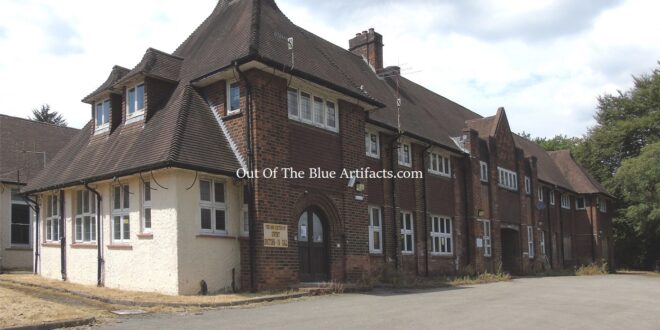Abertillery and District Hospital – Aberbeeg.
The idea of some sort of hospital institution for the district of Abertillery was first raised in the late 1860’s, a subscription scheme and fund were put into place and in 1870 donations were given towards the scheme to generate funds for its construction. At that time a few local doctors were holders of the hospital fund.
In 1890 the Abertillery Chamber of Trade and the Abertillery Local Board began to discuss a cottage hospital for the town of Abertillery. Dr Williams said there was money available in the fund that had been started twenty years previous.
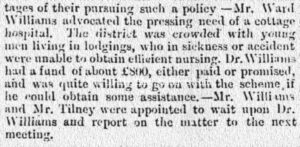 The Need for a Hospital.
The Need for a Hospital.
The urgent need for a hospital at Abertillery was again brought up by Mr John Ward Williams, (Iron Founder) at a monthly meeting of the Abertillery Chamber of Trade, held at the National Schoolrooms, Abertillery on Tuesday 3rd of February 1891. At this meeting the following members attended – Mr L. R. Rogers (Chairman) with Mr W. B. Harrison; Mr W. Jordan; Mr A. Tilney and Dr Williams. At this meeting Mr John Ward Williams advocated the pressing need for a cottage hospital, saying the district was crowded with young men living in lodgings, who, in sickness or accident were unable to obtain efficient nursing. Mr John Ward Williams and Mr A. Tilney were appointed to wait upon Dr Williams report on the matter at the next meeting.
Details and Costs of the Proposed Cottage Hospital.
On Tuesday 3rd of March 1891, at an annual meeting of the Abertillery Chamber of Trade, held at the National Schoolrooms, Abertillery. The following members attended – Mr L. R. Rogers (Chairman); Rev Rees; Mr W. B. Harrison; Mr Joseph Wallace; Mr J. Ward Williams; Mr Jordan; Mr J. Carter; Mr W. Lewis; Mr Ben Powell; Mr Ayers; Mr Emanuel; Mr Jenkyn Williams; Mr G. Scudamore; Mr J. E. Phillips; Mr W. Phillips; Mr C. W. Carpenter; Mr W. Phillips; Mr Moses Thomas; Mr G. Gregory; Mr A. H. Thomas; Mr W. R. Haylings and Mr J. T. Barker (Secretary): At this meeting the proposed cottage hospital was discussed in detail.
Mr John Ward Williams and Mr A. Tilney reported that they had waited upon Dr Williams for the purpose of obtaining information on the above proposal. They found that Dr Williams was very anxious for the establishment of such an hospital and had been promised about £850 towards its erection. The doctor was of the opinion that many deaths could be prevented if proper nursing and attention were obtainable. Mr Arthur Tilney dealt with the financial side of the question. The total amount required for a cottage hospital was stated as being £1,200 for the building, furnishings and appliances, of which sum all but £340 had been promised. The cost of maintenance, matron, food and medicines etc would be about £150 per annum. Mr Tilney suggested that the workmen of the district be approached with a view of seeing if they would contribute one farthing per pound of their wages for the maintenance of such an establishment. Further consideration on the subject was adjourned until the next meeting, though for some unknown reason the subject of a cottage hospital was again adjourned at the following meeting.
The Indefinite Adjournment of the Cottage Hospital.
On Tuesday 2nd of June 1891, at a monthly meeting of the Abertillery Chamber of Trade, held at the National Schoolrooms, Abertillery. The following members attended – Mr Joseph Wallace (Chairman); Mr Jesse Carter; Mr J. Gregory; T. J. Lane; Mr G. Gregory; Mr Moses Thomas; Mr Wilkins; Mr J. Dagger; Mr H. Cole; Mr J. Wright; Mr D. Harris; Mr W. Hill; Mr Jenkin Williams; Mr R. Ayers; Mr T. Lewis; Mr B. Powell; Mr Arthur Tilney; Mr W. R. Haylings and Mr J. T. Baker (Secretary): At this meeting the question of providing a cottage hospital for Abertillery was adjourned indefinitely. It was the opinion of the majority of members present that the scheme at present was not ready to be carried out.
The Renewed Interest in the Cottage Hospital Scheme.
Sometime in the early 1900’s the Abertillery Cottage Hospital Scheme was restarted and a full programme of fund-raising events was organised by a fund-raising Sports & Hospital Committee.
On Monday 27th of August 1900, the Abertillery Council organised a sports day at the Abertillery Park under the auspices of the Abertillery District Council and the leading tradesmen and ratepayers of the district. The programme featured running races, cycling, tug-of-war and a timbering competition. On the same day a grand carnival was held in aid of the erection of a cottage hospital for Abertillery. Tradesmen, friendly societies and ratepayers were invited by the committee to help with this noble cause. All particulars and entrance forms were available from Secretary Mr T. J. Buckley of the Buckley’s Temperance Hotel, Abertillery.
The carnival was later reported as being poorly attended, though the sports competitions was seen as very successful with thousands of spectators. The railway company had to put on extra trains to transport the many people to Abertillery from the neighbouring towns. It was said the weather was fine and profits made on the sporting events were said to have been £130. 16s. 5d. the bathing entertainments were £10. 16s. 0d. and the profits for the hospital fund was £47. 10s. 0d. The total profits were £189. 2s. 5d. That is equivalent to £23,247.00 in todays money. The auditors were Mr A. Jenkins and Mr Frank Padfield.
 On Wednesday 12th of September 1900, Mr Danter’s World Fair came to Abertillery Recreation Grounds, all proceeds going to the cottage hospital fund. There was no known report on the programme of attractions though later Mr Joseph Danter of the Worlds Fair was charged on remand for gambling with a coloured cloth at the fair. He had been observed giving and taking money by P.C. Chappell and was fined 40s.
On Wednesday 12th of September 1900, Mr Danter’s World Fair came to Abertillery Recreation Grounds, all proceeds going to the cottage hospital fund. There was no known report on the programme of attractions though later Mr Joseph Danter of the Worlds Fair was charged on remand for gambling with a coloured cloth at the fair. He had been observed giving and taking money by P.C. Chappell and was fined 40s.
On Wednesday 21st of November 1900, a banquet was held at the Abertillery Market Hall under the auspices of the Cottage Hospital Sports Committee. The hall was decorated by Messrs Morgan & Francis of the Pontlottyn Shop and catering supplied by Mr Charles Judd of the Railway Hotel. Those present included Mr Arthur Tilney (Chairman); Mr W. McNeil (Vice Chairman); Mr J. T. Buckley (Secretary); Mr W. P. Thomas; Mr G. Little; Mr James McBean; Mr W. Harris and Mr W. J. Phillips.
At this social evening the chairman issued the following statement of accounts – The recent sports events raised £46. Mr Fletcher the auctioneer gave £5. Mr Duckworth, of Duckworth & Charlton, the lessees of the Abertillery Metropole Theatre offered to arrange a cantata at his own expense with the aid of Mr Sinclaire the manager. Mr Danter of the Worlds Fair gave a benefit night which raised £25. Several doctors promised their support, though little could be done without the colliery workmen and he was sure the matter would only have to be mentioned to receive their support. Later presentations were made to the following for their assistance in regard to the hospital fund – Mr Danter was presented with a gold pendant. Mr T. J. Buckley was presented with a gold watch, Mr Fletcher was given thanks along with Mr W. J. Phillips. During the evening Mr D. Parsons did a recitation and speech, Mr Harry Devine, Mr G. Morgan and “Funny Tommy” from Mr Fletchers Auction Vans sang songs. Mr H. Renalt accompanied on the piano.
On Tuesday 26th of February 1901, the Hospital Fund Committee under the chairmanship of Mr Arthur Tilney met at the Abertillery Council Offices. It was reported that the Six Bells Colliery workmen had decided to pay a poundage of 1/2d. (one half-penny) per £1 towards the cottage hospital.
Hospital Sunday.
On Sunday 12th of May 1901, the “Cottage Hospital Sunday” was inaugurated at Abertillery, a large number of people turned out to witness the procession which started at the Abertillery Council Offices. It was headed by the Abertillery Fire Brigade, the officers in charge were Captain W. Pittaway and Lieut J. Brittan. The Tillery Band were followed by H. Company 3rd V.B., S.W.B., the commanding officers being Lieut Williams and Lieut- Major Cook. Then came the Arrael Griffin Band closely followed by the district councillors, the Cottage Hospital Fund Committee, employees of the council and the general public. A service was held at the Abertillery Market Hall by Rev J. Marks Evans attended by the district councillors, the hospital committee and County Councillor Mr W. Brace. Rev J. Marks Evans took for his discourse the text – “Render unto Caesar the things that are Caesar’s and unto God the things that are God’s”. The Arrael Griffin Band was conducted by Mr Harry Bentley and the Tillery Band by Mr J. Griffiths. After the sermon Mr W. McNeil (Treasurer) gave out the result of the collections, which was as follows – Taken on route £4. 4s. 9d. collected at the service £8. 12s. 1d. Total £12. 16s 10d. Councillor W. P. Thomas J.P. the chairman of the district council was credited with the idea and he hoped it would become an annual event.
Whit-Wednesday Sports Event.
On Wednesday 29th of May 1901, a grand sports event in aid of the fund to erect a cottage hospital in Abertillery took place at Abertillery Recreation Grounds, it was reported that the weather was beautiful and the sports were witnessed by nearly 10,000 spectators. The officials at the events were as follows – Dr W. E. Williams J.P., (President); Mr Arthur Tilney (Chairman of the Sports Committee): Messrs J. Young of Newport; Mr Charles Telford Evans of Cardiff; Mr James McBean of Abertillery and Dr Muir of Cwmtillery were (Judges): Mr Noel Bagley of Abertillery (Starter): Messrs Quick; W. Hancock; W. Richardson and W. Powell (Stewards): Messrs Geo Hilliard; F. Athay; and A. H. Dolman (Clerks of the Course): Messrs W. Wicks; J. Ralph; George Russell; J. Williams and W. J. Phillips (Enclosure Stewards): Councillors W. McNeil and E. J. Williams (Treasurers of the Hospital Fund): Councillor T. J. Buckley (Sports and General Secretary) and Mr George Harris (Assistant Secretary): The handicappers were – Mr C. Herbert A.A.A., of London and Mr Brind N.C.U., of Cardiff.
There were numerous entries at the sports events, too many to list (though a full list of participants and winners etc can be supplied if needed). The athletes came from places such as Newport, Cardiff, Swansea, Abergavenny, Mountain Ash, Rogerstone and Tylorstown. Several accidents occurred during the afternoon cycle races, four fell at one corner and in the final of the Mile Handicap, Mr Oliver Davies of Abertillery collided with Mr R. Jones of Tylorstown. Mr Oliver Davies received a compound fracture to his left arm, Mr Jones was badly shaken and both men had to be carried off. Later the same day it was reported a travelling jeweller came to indulge in some trickery at the park and was mobbed by the large crowd, he was pushed off his horse and ducked in the river, it said (He made good his escape). The money raised at the sports event amounted to £223. 15s. 0d. receipts from the gate money and tolls for stands on the grounds. The amount collected – £223. 15s. 0d. is equivalent to £27,000. in today’s money.
On Thursday 6th of June 1901, the Abertillery Hospital Fund Committee met and discussed the accident that caused the fracture to Mr Oliver Davies arm the previous month, they agreed that as Mr Oliver Davies was taking part in raising funds for the cottage hospital whilst he received the accident it was only right that he should receive some sort of compensation, the committee granted him 10s. per week from the funds. It didn’t say how long the payments lasted. In the same meeting it was reported that the Cottage Hospital Site Sub-Committee had met the previous Tuesday for the purpose of selecting sites for the cottage hospital. Three sites were recommended for the approval of the General Committee, Six Bells was suggested as the most suitable.
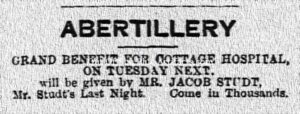 On Tuesday 18th of June 1901, Mr Jacob Studt again came to Abertillery with his famous “World’s Fair” and this time devoted the proceeds of his last night’s show to the Abertillery Cottage Hospital Fund. The proprietor of the Boxing Booths gave his days takings of £1. 4s. 0d. the total which amounted to £40 did not include the children’s money taken at the schools.
On Tuesday 18th of June 1901, Mr Jacob Studt again came to Abertillery with his famous “World’s Fair” and this time devoted the proceeds of his last night’s show to the Abertillery Cottage Hospital Fund. The proprietor of the Boxing Booths gave his days takings of £1. 4s. 0d. the total which amounted to £40 did not include the children’s money taken at the schools.
On Wednesday 7th of August 1901, another sporting event to raise funds for the Abertillery Cottage Hospital took place at Abertillery Recreational Grounds. The event didn’t bring in the large crowds as before even though it was reported that the Hospital Sports Committee offered a great amount of prize money to the competitors in the hope it would draw great interest among spectators. The total prize fund given out for eight races was £70 that is equivalent to £8,500 in today’s money. As an example the 120 yard open handicap, first of the races had a prize pot of £11, the 1st prize was £6, 2nd prize £3 and the 3rd prize being £2. That is the equivalent of £700, £350 and £234 respectively in today’s money. Even though the sporting event didn’t generate the money at the gate, the large prize pot shared between the various sporting events did bring in many competitors from around the country, the athletes came from places such as Bristol, London, Usk, Bradford, Mountain Ash and Cardiff.
In Feb 1902 Mr W. J. Phillips took over as secretary of the Abertillery Hospital Committee from the late Mr T. J. Buckley.
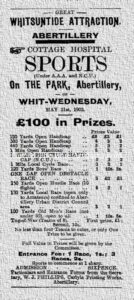 On Wednesday 21st of May 1902, another sporting event to raise funds for the Abertillery Cottage Hospital took place at Abertillery Recreational Grounds. The prize fund was advertised as being £100. (as seen right). The event was seen as a success and over £150 was taken on the gate.
On Wednesday 21st of May 1902, another sporting event to raise funds for the Abertillery Cottage Hospital took place at Abertillery Recreational Grounds. The prize fund was advertised as being £100. (as seen right). The event was seen as a success and over £150 was taken on the gate.
In May 1902 a site for the proposed Abertillery Cottage Hospital had been decided upon, negotiations where were being made between Mr L. E. Webb for a piece of land (one acre) behind Duke Street, Abertillery which had been secured on a lease for 99 years at a rental of £10 per annum.
In August 1902 Mr W. J. Phillips, the secretary of the Abertillery Cottage Hospital Committee reported they had a balance of £400 in the account at the bank. Over the next few years more fund-raising events took place at the Abertillery Recreational Grounds along with street collections etc.
Arrael Griffin Colliery Nurse Appointment.
Since February 1901, the workmen of the Arrael Griffin Colliery, Six Bells had been paying the sum of 1/2d. (one half-penny) per £1 into the cottage hospital scheme. Because of the lack of urgency in connection with the setting up of a hospital, the Six Bells Colliery workmen appointed a fully qualified nurse to be stationed at the colliery to tend to accident cases on the premises, the nurse was funded from their Cottage Hospital Subscription Fund. The lodge stated this would no way interfere with their current commitment to fund a cottage hospital for the district.
For many years the Abertillery Cottage Hospital Fund became dormant, though in 1905 the committee, now under the chairmanship of Mr B. C. Denning had become more active.
On Wednesday 10th of May 1905, Mr C. B. Denning presided over a meeting held at Coed Iorwg Abertillery. Mr W. J. Phillips (Secretary) reported the result of the ballot on the question of the miners contributing a half-penny per week. The following is the majority shown at the various pits – Arrael Griffin Colliery 360; Tillery Penybont Colliery 141; Gray Colliery 160; Cwmtillery Colliery 184; Aberbeeg Colliery 127; Roseheyworth Colliery 71; The Railway Servants 45: The Vivian Colliery had not taken a ballot. It was decided to allow the Abertillery District Council employees to have a ballot. Later the tin workers had a ballot on the contribution of a half-penny per week and of the eighty-five workmen the vote was (73 to 12) in favour, with a majority of 61 votes.
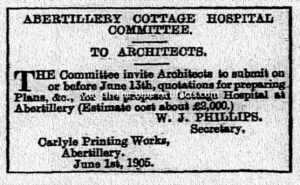 Tenders for the Planning of the Cottage Hospital.
Tenders for the Planning of the Cottage Hospital.
In June 1905 tenders were invited by the Abertillery Cottage Hospital Committee to architects to prepare plans etc for a cottage hospital with a estimated cost of £2,000. Tenders to be handed in to Mr W. J. Phillips, secretary, Carlyle Printing Works, Abertillery.
Whitsun Sports Event.
In June 1905 the Abertillery District Council had laid down a new asphalt cycle track to replace the old ash cinder track and it was to be officially opened during the Annual Whitsun Sports Day in aid of the Cottage Hospital Fund on Tuesday June 13th, 1905. The sporting events were held over two days, the Tuesday 13th of June and Wednesday 14th of June. On the Tuesday Mr A. W. Coles of Abertillery attempted a ten-mile cycle record on the new track paced by Mr E. C. Pullman of Merthyr on a motorcycle, Mr Coles had to retire from the event after breaking his chain. Mr Pullman gave a five-mile exhibition on his motorcycle finishing in 10 minutes 54.5 seconds. On the Wednesday in the final of the Half-Mile Open Cycle Handicap race Mr Wayne of Cwmtillery and Mr Harold Smith both fell off their bikes when a dog ran across the track. The proceeds of the two-day event to the Cottage Hospital Fund totalled £149 in addition a large number of tickets had been sold and had yet been accounted for.
On Wednesday 21st of June 1905 the Abertillery Cottage Hospital Committee met at Coed Iorwg, Abertillery. Mr W. J. Phillips (Secretary) reported he had received estimates for preparing plans and supervising the erection of a cottage hospital from thirteen architects and they were referred to the sub-committee.
On Friday 30th of June 1905, the South Wales Gazette printed a letter from a reader who was against the idea of building the cottage hospital at that point in time, the person wrote, was it a good idea, who gave the permission to invite tenders, was there sufficient money in the fund, what percentage of workmen would subscribe and would it be fair as they would be unduly burdened. The person warned of the burden on the workforce, they knew the need for some sort of hospital though wanted the Abertillery Urban District Council to build a cottage hospital from the rates, that way all residents could pay an equal share.
In November 1905 it was reported in the South Wales Gazette that the workmen at various collieries had agreed to become subscribers to the Abertillery Cottage Hospital Fund (with privileges) by allowing one half-penny per week to be deducted from their wages. The committee also invited the general public to participate in the same. The subscriptions could be received in yearly, half-yearly or quarterly instalments, as desired and were to be sent in by the intending subscribers from September 1st, 1905. Secretary Mr W. J. Phillips, Carlyle Printing Works, Abertillery.
Yet again, the Abertillery Cottage Hospital Fund became dormant for many years, though in August 1908 a Trades Council meeting was held in the Tillery Institute under the chairmanship of Mr G. Phillips. It was stated a movement had been started many years ago and the money raised had been left in the bank. Mr Snellgrove said he thought a cottage hospital was still needed and though it was time to ask the Abertillery District Council to take the initiative on the matter. The suggestion was adopted and Mr J. Johns, Mr O. Purnell, Mr J. Snellgrove and Mr T. Mytton with the chairman and secretary were appointed to form a deputation.
On Monday 12th of October 1908, at a meeting of the Abertillery District Council, Mr D. Smith (Vice Chairman) received a deputation from the Trades and Labour Council consisting of Mr G. Rogers (Chairman), Mr J. Emlyn Evans (Secretary) and Mr J. Snellgrove. They put before the council the question of the provision of a cottage hospital. Mr Snellgrove explained that they were a deputation from the Trades and Labour Council of the district who were waiting on the Abertillery District Council to bring before the council the need for the provision of a cottage hospital in their district. He was aware of the hard work that had been done in the past in raising funds to erect such an institution out of the workers contributions but he thought it time to ask the Abertillery District Council with all the rate payers to erect and carry on such a place. Some time ago the Trades Council were told by the council that they had no power to erect a cottage hospital but Mr Snellgrove believed that the Local Government Board had decided that urban authorities had the power. Such authorities had indeed built hospitals and there was a need for an hospital in this mining district.
It was stated Cardiff and Newport Hospitals were full and cases at Abertillery could not be admitted to these places. Mr Athay said there was not the slightest doubt that every member had sympathy with the object of the deputation, at the same time it was a most serious question and would require very careful consideration the hands of the council. Mr Theo Jones said it would be unfair for the council to take the matter of a provision of a cottage hospital until they knew the whole district wanted it. He spoke of how he had heard the workmen in Llanhilleth were not in favour. Mr J. Carter agreed and said the Llanhilleth workmen were against the proposal and were happy with the facilities at Newport Hospital. Mr W. Lewis spoke in support of the proposal and said the Abercarn Council may want to go in for a joint hospital in some central site. Mr Snellgrove responded and said the Trades and Labour Council hadn’t discussed where the hospital would be built, if there was a good site in Llanhilleth it could be built there, the only thing they wanted was a local hospital where their injured men could be taken.
On Monday 8th of August 1910, at a monthly meeting of the Abertillery District Council held at the District Offices Abertillery, Mr W. Gait (Clerk), read a letter from Mr J. K. Millward (Secretary Superintendent) of the Newport and Monmouthshire Hospital. In the letter Mr Millward asked if the Abertillery Urban District Council would kindly assist the directors of the Newport and Monmouthshire Hospital by an annual subscription to its funds. He stated a large number of patients were treated there. In the year 1909 – 39 in-patients and 123 out-patients were attended to. He stated the hospital was maintained entirely by voluntary contributions and it was the only hospital that met the demands of the whole of the county.
Mr Millward gave a guidance as to what was being contributed by other district councils, Magor District Council were subscribing £5. 5s. 0d. St Mellons District Council were subscribing £10. 10s. 0d. and considering the small number of patients from these districts as compared to Abertillery the institution has a great claim on the Abertillery Council. Mr Athay seconded the motion and Mr Phillips said he would ask the council to contribute £30 for the year if sanction was obtained. Alderman Thomas brought up the Abertillery Cottage Hospital proposal and the fund in existence for that purpose, as if the idea was given up, he thought the money could be sent to Newport. Mr Phillips denied the idea of a hospital at Abertillery had been abandoned.
A short while later it was stated that the Abertillery Urban District Council had sent contributions to Newport Hospital and also Cardiff Hospital.
The Welsh Memorial Proposal.
In February 1911 in connection with a Welsh Memorial to the late King Edward VII there was a campaign against tuberculosis with an exhibition at Abertillery. Mr G. Rogers stated that even though people were sympathetic with a national memorial he believed the provision of a local cottage hospital would be more beneficial in their district.
On Wednesday 8th of February 1911, an annual meeting of the Trades and Labour Council was held at the Powell’s Tillery Institute, Abertillery. Mr T. Mytton presided over a large audience of delegates, Mr G. Rogers said a special meeting was to be arranged to consider the position of Abertillery in reference to the National Memorial to the late King. There was a sum in the bank towards the erection of a cottage hospital and he thought that such a scheme would be a more fitting memorial than the proposed tuberculosis campaign. The £500 might be devoted to the Cottage Hospital Scheme. Mr Snellgrove and Mr J. Phillips agreed and stated the money now being sent to Newport and Cardiff Hospitals could be spent in connection with a local hospital. Mr Rogers hoped the members would give their support though the subject was dropped.
On Wednesday 2nd of April 1913, a meeting of the Trades and Labour Council was held at the Powell’s Tillery Institute, Abertillery. At this meeting the need for a local hospital was again discussed. The navvies union and the Cwmtillery and Gray Colliery lodges were in favour of the proposal, Mr Hughes (Minutes Secretary) seconded the motion and said that only recently a man bled to death owing to him being taken to Newport to be treated. Mr Snellgrove supported the motion and said the men from the lower valley were now in favour in view of what had recently happened. At this time there was £600 in the bank and suggested a mass meeting should be held to discuss the matter. Mr Sheen said that the motion should be altered in favour of a municipal hospital instead of a cottage hospital and said Blaina had gained the lead of Abertillery in that matter. After further discussion it was decided to invite the Miners Council, the Ratepayers Association, the Free Church Council and the Grocers and Master Bakers Association to nominate a member to co-operate with a deputation from the Trades and Labour Council to take up the matter. Mr Opton Purnell was later appointed as delegate for the Miners Council.
After many years of trying to get a cottage hospital at Abertillery the residents of the district were still divided in whether to accept its proposal. Many public meetings were held in the district to debate its implications and the workmen were also divided and were quibbling of the levy, at a miners meeting in the Tillery Institute a delegate stated men were not voting as the levy towards the hospital was not printed on the ballot papers. Workmen knew the levy was 1d. in the pound but still refused as it was not printed on the sheets. The Vivian Colliery lodge were the wariest and was opposed to the idea altogether.
In 1915 Mr Thomas Mytton became chairman of the Workmen’s Committee in connection with the proposed cottage hospital. He later was one of a deputation of three who visited other hospital sites in the neighbourhood, as a result their reports initiated the Cottage Hospital scheme.
The Ballot.
In May 1916 the workmen at the various collieries were balloted on the question of the provision of a cottage hospital for Abertillery, the results were as follows –
Arrael Griffin Colliery – for 1,258, against 559, spoilt votes 21.
Vivian Colliery – for 432, against 526, spoilt 8.
Penybont Colliery – for 556, against 277 spoilt 10.
Gray Colliery – for 358, against 109.
Cwmtillery & Rose Heyworth Colliery – for 1,289, against 360, spoilt 15.
National Union of Railway men, Aberbeeg Branch – for 82, against 12.
National Union of Railway men, Abertillery Branch – for 51, against 6.
Associated Locomotive Drivers and Firemen – for 25, against 2.
Operative Bricklayers – for 8, against 1.
The figures gave a total of 4,086 for the scheme and 1,853 against, leaving a majority in favour of 2,234.
Site for the Cottage Hospital.
On Monday 2nd of October 1916, a meeting was held at the Powell’s Tillery Institute, Abertillery in connection with the Abertillery Cottage Hospital scheme. Mr Tom Mytton (Chairman) with Mr W. Davies (Vice Chairman). Mr Mytton stated the Site Committee had interviewed Mr Vachell, who had offered then a site south of Cwm Farm, Abertillery and had asked Dr T. Baillie-Smith to report has to its suitability.
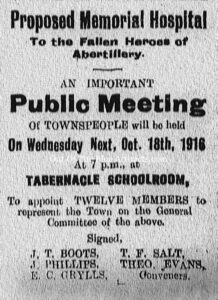 Proposed Memorial Hospital.
Proposed Memorial Hospital.
On Wednesday 11th of October 1916, a public meeting was held in the Tabernacle Congregational Schoolroom, Abertillery to consider the proposal to erect a cottage hospital for Abertillery and neighbourhood. Mr J. T. Boots presided supported by Mr Leolin Forestier-Walker J.P., C.C. Mr Boots spoke of how they were going through a great crisis, being engaged in a bloody war and millions of boys had gone out to stand between us and the foe, in time to come every town and village in the country will be thinking of erecting some memorial to keep green the memory of those dear boys who had laid down their lives in that great cause. Mr Boots suggested that the memorial they should endeavour to erect in Abertillery to commemorate their deeds of valour should take the form of a cottage hospital for the district.
He was delighted that the colliers from Aberbeeg to Cwmtillery and Rose Heyworth had voted in favour of levying themselves on the poundage scheme for a hospital. The first suggestion was to call it the Abertillery Cottage Hospital though Mr Boots suggested that a better name would be the Abertillery Memorial Hospital, with the names of all local heroes, both – those who came back and those who would never come back – inscribed on a tablet in the hall of the hospital. The building, equipping and administrating of a hospital was a simple matter, they had permission and planning but the great question was finance, he thought the miners had at least given a lead on the financial side. There were roughly 7,000 miners in the district who had agreed to contribute 1d. (one penny) in the pound, their average earnings were £2 a week, that would give them £3,000 annual income to the hospital.
Mr Athay said “With a population of more than 40,000 people there should be a hospital at Abertillery”, the motion was carried and Mr J. T. Boots, Mr John Phillips, Mr T. F. Salt, Mr Theophilus Evans and Mr E. C. Grylls were appointed a committee to call a special meeting of the townspeople to consider what their contribution to the matter should be and to appoint representatives.
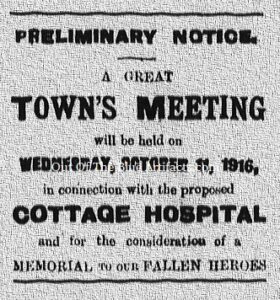 The Town Meeting.
The Town Meeting.
On Wednesday 18th of October 1916, the town meeting was held at the Tabernacle Congregational Schoolroom, Abertillery for the purpose of considering the desirability of appointing a committee representing the “Town & Trade” to co-operate with the existing Provisional Committee elected by the labour organisations to promote the Cottage Hospital Scheme. Mr J. T. Boots presided over a disappointingly small attendance including Rev J. Marks Evans; Adjutant Hill (Salvation Army); Mr T. F. Salt; Mr L. H. Lewis; Mr E. C. Grylls; Mr Theophilus Evans; Mr John Phillips; Mr Owen Roberts B.A.; Mr H. Rees; Mr E. A. Hancock; Mr W. J. Phillips; Mr S. Thomas and Mr A. J. Morgan: The chairman explained the workmen from Aberbeeg to the top of the district had decided to go in for a hospital and that it was decided to call it a Memorial Hospital, he hoped all parties would come together and unite to make it a great success.
The Hospital Committee.
Between 1916 – 1920 the Mr W. H. Hiley was secretary of the Town Committee. The members of the Hospital Committee were as follows – Mr T. H. Mytton (Chairman); Mr William Davies (Vice Chairman); Mr William Bowen and Mr Victor Roberts (General Secretaries); Mr Idris Morgan and Mr Wyndham Collier (Financial Secretaries) and Mr Ted Gill: The Trustees were – Messrs J. Snellgrove; William Adams; George Edwards; Mr ? Edwards; Howell Davies A. Parry and J. Jones of Aberbeeg:
Mr John Phillips moved they appoint representatives from the meeting to co-operate with the Provisional Committee. Mr Theophilus Evans seconded the motion which was supported by Rev J. Marks Evans and was carried. The following were appointed to represent the townspeople – Mr J. T. Boots; Mr A. J. Morgan; Mr F. Athay; Mr T. F. Salt; Mr John Phillips; Mr L. H. Lewis; Mr Thophilus Evans; Adjutant J. Hill; Mr E. A. Hancock; Mr W. H. Hiley; Mr O. N. Roberts B.A.; and Rev J. Marks Evans:
The following information was taken from an interview with Mr Thomas H. Mytton – Printed in the South Wales Gazette in 1922.
In late 1916 the Hospital Committee had a duty to get the money from the old fund and found it was far from easy to transfer the money. Half of the old trustees had passed away and others had left the district. It was only with the assistance of Mr Phillips and Mr Snellgrove, Mr Edward Edwards and Mr George Edwards the three remaining trustees along with Mr T. J. Roberts the manager of the Midland Bank that they were to accomplish this even though it took over 12 months to achieve.
The Hospital Site at Christchurch, Aberbeeg.
The sites proposed at Abertillery had been discarded in favour of a site on elevated ground at Christchurch, Aberbeeg. This site was proposed as being situated in a healthy spot, in acres of ground and on freehold land. The land was secured from the Hanbury Estate at a rental of £60 per annum with the present owners during their lifetime would give an annual donation of £60 towards the upkeep, which meant that the land was practically a gift and the company’s architect was put at their disposal. Mr Vachell was instructed to convey their thanks to Messrs Webb, Mr Dolman was instructed to get in touch with the solicitor of the estate Mr Coulman of Newport to draw up the lease. Things didn’t start to well though and it was discovered the present lessee still had another twelve years left on his lease and had to be paid off. The Cottage Hospital Committee had a meeting with the Ebbw Vale Company in regards for financial aid and met with Mr Northgraves, the general secretary, Mr Falcon the general manager and Mr Jefferies of Six Bells.
The company agreed to assist as long as the Cottage Hospital Committee would draw up a draft of of the scheme and submit it to the company. The Hospital Committee had a special meeting to consider a draft scheme to place before the company. The scheme submitted was as follows –
1/ The hospital was to be called the “Abertillery and District Hospital”.
2/ The deeds etc be placed in the hands of 12 trustees as follows – Five from workmen, three from the hospital fund, three from the employers and one from the townspeople.
3/ The committee of management to consist of a board of 25-15 from the workmen, 8 from the employers and two from the town and the chairman to be elected annually.
This scheme was submitted to Mr Falcon on January 2nd, 1917. The Cottage Hospital Committee was also told of how the Ebbw Vale Company would offer to build the hospital and contribute 50 per cent to its maintenance.
When this site and scheme was approved a regular system of contributions was put into place. The whole of the colliery workmen from Aberbeeg to Cwmtillery contributed from this time, together with the tin works men, teachers and other members of other trades and professions and between 1916 and 1920 over £30,000 had been collected. In addition to this a Town Committee had been formed to which those who had not contributed in other ways were invited to add their donations and between the same dates £500 had been collected. This figure was seen by many as meagre but in their defence many were holding back on donations until the hospital had been built.
The War Years and the Financial Crisis.
In 1917 there was still no signs of a hospital being built and in August 1917 the officials were asked to call a special meeting. The meeting considered the advisability of erecting a temporary hospital until a permanent one was constructed. It was reported that the people were paying money into the fund but could not see signs of a commencement. The Cottage Hospital Committee arranged a meeting with the Ebbw Vale Company with regards to the delay and they informed the committee that owing to the agents of the estate Messrs Foster Brown & Company being so busy and understaffed they could not make progress. The company also said they had no objections to the committee’s proposal to build a temporary hospital and had asked the secretary to write to various firms and get quotations for such up to £7,000. The Cottage Hospital Committee decided to accept the tender of Messrs Cowerson of Glasgow at £7,000 for the erection of a temporary wooden hospital of twenty- beds, though before this was confirmed the company had to get a permit from the Minister of Munitions, Mr Churchill to allow the firm to build. Again, the hospital committee was up against a wall.
Before getting the building permit, the hospital committee had to interview Mr William Brace M.P., Mr Thomas Richards M.P., and others to get the minister to meet them as at that time during the war it was hard to get a coupon to buy some sugar let alone a permit to build a hospital. The minister agreed to meet with the committee on the 3rd of January 1918 where he approved the permit for £7,000. The committee then met with Sir John Wyndham Beynon, Mr Walter Rosser M.S.A., Mr Owen and Mr Vachell to submit the plans.
In February 1918 the hospital committee met the four gentlemen at Cwm Farm, Abertillery to discuss the proposed temporary wooden hospital on that site. The architect Mr Rosser gave the disadvantages of building such a hospital and the hospital committee agreed with him and took his recommendation to build one of light brick instead, in that the advantage would be that it could be used as an auxiliary hospital when a permanent one had been erected. The hospital committee pointed out the difficulty in obtaining bricks and Sir John Wyndham Beynon gave his assurance that he would get them supplied. Once again, the scheme hit a wall as the estimate for a light-brick hospital building was £20,000 and the permit only allowed £7,000 to be expended on materials. At this point the difficulties were far greater than they were before.
The hospital committee decided to push ahead and not let it get the better of them, they met with Sir John Wyndham Beynon, Sir Frederick Mills and Mr Northgraves on behalf of the Company, instructed the architect Mr Rosser to get the plans out and they once again headed toward London to approach the minister with their renewed vigour and an appeal for a permit to build a light-brick building for £20,000.
On May 30th, 1918, the deputation went to the ministry to ask for the £20,000 permit for the construction of the hospital, Mr Brace and Mr Richards made a strong appeal and Dr T. B. Smith pointed out the seriousness of the situation from his professional standpoint. The minister promised he would do what he could. At this point the hospital committee stated they had £9,565. 8s. 0d. in the bank.
On 4th November 1918 the permit for the £20,000 to construct the light-brick hospital was acquired, before the hospital committee could rejoice the Vivian Colliery Lodge put in a motion against the scheme. They had said that now the war was over the hospital committee should abandon the plans to build a temporary hospital and go on with the permanent one at Christchurch, Aberbeeg. As the committee was about to turn their motion down by coincidence or other the Ebbw Vale Company suggested the same. The Cottage Hospital Scheme was again at a standstill. It was of the opinion of all main parties to wait for the building of a permanent hospital at Aberbeeg, the company gave their assurance that they would commence operations as soon as possible.
On February 20th, 1919, it was unanimously decided to accept the hospital committee’s recommendation. The committee waited until July for the company to commence operations and then again pressed them to proceed. At this time Mr William Bowen (Secretary) of the hospital committee resigned as he was leaving the country and Mr Idris Morgan (Financial Secretary) also left his post, on top of that the Sankey Report was issued and labour troubles were brewing. The hospital committee received a communication from the Ebbw Vale Company with effect that they had to withdraw their offer to construct the hospital, Sir Frederick Mills stated that the coal controller would not sanction the expenditure of the company. At this time the hospital committee’s morale was at such a low ebb though they felt compelled to carry on with the scheme on their own and approached Mr Hanbury to negotiate for the site at Aberbeeg, they met with Mr Tyler of Pontypool who was more than helpful. Mr Tyler explained he could not give any land as he was only a trustee though he was willing for the hospital committee to purchase it from Mr Hanbury outright and Mr Hanbury would also donate £500 out of his personal account to help with any fees etc.
The hospital committee unanimously agreed with the offer and set the new scheme into motion. The committee once again called for the valuable services of the architect Mr Walter Rosser M.S.A., who in the meantime had finished with the Ebbw Vale Company and had resided in Newport. The architect put out tenders for builders to construct the hospital at Aberbeeg though the committee was having a hard time getting anyone to offer their services, it seems that at this time the prices of building materials was fluctuating so badly builders were reluctant to send in fixed tenders, some were sending in various percentage tenders. Mr Victor Roberts, Mr Walter Rosser (Architect) and Mr Thomas Mytton interview some of the builders and chose the services of Mr John Henry Monks of Newport.
The Contractor and Architect.
The contractor was Mr John Henry Monks of Newport. The architect was Mr Walter Prosser M.S.A. of Newport and London.
The Cutting of the Sod.
In April 1920 the first sod was cut of the Abertillery and District Hospital, Christchurch, Aberbeeg. The Cottage Hospital Committee decided to ask Mr Le Brasseur of Newport, Solicitor to Messrs Webb, Aberbeeg if he would kindly approach Mr Webb for a donation, Mr Webb obliged and donated £1,000 to endow two beds in the name of Mr Edgar Webb.
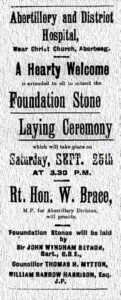 The Stone Laying Ceremony.
The Stone Laying Ceremony.
On Saturday 25th of September 1920, the Stone Laying Ceremony took place at the site of the Abertillery Cottage Hospital, Christchurch, Aberbeeg. The work was carried out by Mr John Henry Monks of Newport at an estimated cost of £40,000 to £50,000. The architect was Mr Walter Prosser M.S.A., of Newport and London. At the ceremony a platform was erected in front of the three stones which were to be laid and this was occupied by the following – Mr William Davies (in the absence of the Right Honourable W. Brace M.P.); Sir John Wyndham Beynon, Bart C.B.E.; Mr L. F. Beynon; Sir Henry Mather Jackson; Mr A. B. Sweet-Escott (General Manager of the Ebbw Vale and Associated Collieries); Mr Bertram Northgraves (Secretary); Mr W. H. John (Chief Colliery Manager of the Ebbw Vale Group); Mr B. Owen (Chief Manager of the Messrs Lancaster and Powell’s Tillery Collieries); Dr W. J. Greer of Newport; Revs J. Marks Evans; D. Collier; Ivor Evans and W. J. Thomas; Mr O. Roberts B.A.; Mr Victor Roberts; Mr Walter Rosser; Mr John Monks; Mr W. B. Harrison J.P.; Mr T. H. Mytton; Messrs T. Griffiths and J. Williams (representing the Abercarn Urban District Council) and others:
After many letters of apology were read from those who sadly could not attend, it was told that for the past few years the workers had contributed towards the proposed hospital though the war had delayed the whole project though had not dampened the aspirations of the workers. At this time over £28,200 had been contributed, the land upon which the hospital was to be built was purchased for £1,100 and was freehold.
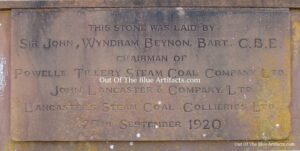 The First Foundation Stone.
The First Foundation Stone.
The first Foundation Stone was laid by Sir John Wyndham Beynon on behalf of the Powell’s Tillery Steam Coal Company Ltd and Messrs Lancasters Steam Coal Company Ltd. After laying the Stone Sir John Wyndham Beynon then announced that he had been given permission from his colleagues on the various boards to give as a donation £5,000 to the hospital and in addition they would give another £5,000 to the hospital and in addition to that they would also subscribe 25 per cent of the amount their workforce in three collieries would subscribe.
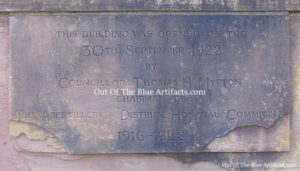 The Second Foundation Stone.
The Second Foundation Stone.
The second Foundation Stone was laid by Mr Thomas Mytton on behalf of the workmen of the Powell’s Tillery Steam Coal Company Ltd, Messrs John Lancaster & Co and Lancaster’s Steam Coal Company Ltd. Mr Mytton spoke of how it had been a necessity to erect a hospital for the district and the workers were going to work every day knowing the suffering of many of their fellow workers day after day but it had not been until 1915 that they were able to get the workers united on this matter.
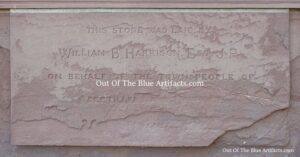 The Third Foundation Stone.
The Third Foundation Stone.
The third and last Foundation Stone was laid by Mr W. B. Harrison J.P. on behalf of the townspeople of Abertillery. Mr Harrison admitted that the sum realised by the townspeople only totalled £550 out of such a large population and wished the amount was more, though he praised the magnificent and valuable subscription of £1,000 donated by Mr J. Edgar Webb bringing the total to £1,550.
The three stone layers, Sir John Wyndham Beynon, Mr Thomas Mytton and Mr W. B. Harrison were each presented by the architect with a silver trowel as a memento of the occasion.
The Luncheon.
After the ceremony a cold luncheon was served at the Hanbury Hotel, Aberbeeg and in the evening entertainment was provided by the songs sung by Mr George Williams and a recital by Mr C. Thorne who recited the “Parson’s Idol”.
The Miners Lock-Out of 1921.
Great credit was due to the workmen who had contributed to the Cottage Hospital Scheme, they had subscribed £40,000 towards the hospital. Up until now the hospital committee had refrained from making any special appeal to the public, though owing to the industrial trouble in the district they had no income from the workmen for nearly a year. They were in a position where they either had to stop work or get an overdraft of £20,000., to complete the hospital, The hospital committee decided against an overdraft as it was their ambition to open the hospital debt free. The committee stopped work until the financial situation in the district improved. Work did resume not long after the bitter dispute ended in the summer of 1921.
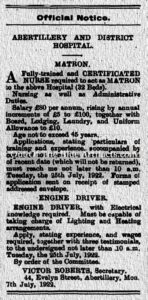 In July 1922 tenders were invited (as seen right) for a fully trained and certified nurse required to act as a matron to 32 beds at the Abertillery and District Hospital, Aberbeeg. The post was for nursing and administrative duties with a salary of £80 per annum, rising by annual increments of £10 to £100. Together with board, lodging, laundry and uniform allowance to £10. Age not to exceed 45 years. Also required was an engine driver with electrical knowledge, must be capable of taking charge of lighting and heating arrangements.
In July 1922 tenders were invited (as seen right) for a fully trained and certified nurse required to act as a matron to 32 beds at the Abertillery and District Hospital, Aberbeeg. The post was for nursing and administrative duties with a salary of £80 per annum, rising by annual increments of £10 to £100. Together with board, lodging, laundry and uniform allowance to £10. Age not to exceed 45 years. Also required was an engine driver with electrical knowledge, must be capable of taking charge of lighting and heating arrangements.
All applications to be sent to Mr Victor Roberts, Secretary, 44 Evelyn Street, Abertillery, Mon. Dated July 7th, 1922.
The Matron.
The post of Matron at the Abertillery and District Hospital was given to Nurse Miss Mary Jane Downing.
The Linen League.
In August 1922 meetings were held by a group of ladies in the Abertillery district with the view of setting up a guild to help the hospital in some way and on Wednesday 23rd August a meeting was held in the Tabernacle Schoolroom to organise a group to supply garments and linen for the use of patients during their stay at the Abertillery District Hospital. It was stated various committees were to be set up and the garments was to be made by the members of the guild in the various districts.
Mr Thomas Mytton initially took the chair in the early evening, it was later taken by Mrs Adams. Reports were received from Mrs Thomas, Mrs Gay, Mrs Wilcox and Mrs Adams from their districts and it was decided that the Management or Executive Committee should consist of the officers and three other delegates from each of the district committees. The following officers were appointed – Mrs Adams (President); Mrs F. Athay (Vice President); Mrs A. H. Dolman (Treasurer) and Mrs R. Green (Secretary): A deputation of four officers was chosen to await upon the Provisional Committee to ask for a grant for the purpose of making garments. On the motion of Mrs Dolman it was decided that the society should be known as “The Abertillery and District Hospital Linen League”.
In September 1922 there was a meeting in connection with the Linen League established for the Abertillery District Hospital. The officers for the various District Committees were as follows – Cwmtillery – Mrs Wearm (President); Mrs Gwilym (Vice President); Mrs Thomas (Secretary) and Mrs Langdon (Treasurer): Bleanau Gwent – Mrs Adams (President); Mrs Dolman (Vice President); Mrs Badger (Secretary) and Mrs Purnell (Treasurer): Central – Mrs J. Prichard (President); Mrs T. Carter (Vice President); Mrs O. Brooks (Secretary) and Mrs T. Wright (Treasurer): Six Bells – Mrs Daggar (President); Mrs F. Brown (Vice President) and Mrs Wilcox (Treasurer): A short while later a meeting was held at the Tillery Institute, Abertillery to welcome Mrs Rhys Williams, Miss Dixon and Miss Knowles of Aberbeeg as representatives of the lower area.
Tenders for Staff.
On Friday 15th of September 1922, tenders were put out in the South Wales Gazette Newspaper for various staff at the Abertillery and District Hospital, Aberbeeg.
Probationers were required – Applicants were to be over 18 years of age. The salary was £20 for the first year, £25 second year and £30 in the third year, with lodging, washing and indoor uniform.
A General Cook was required – With a salary of £36 per annum, with lodging, washing and indoor uniform.
Ward Maids were required – Wages were 10/- shillings per week, with lodging, washing and indoor uniform.
All applications to be sent to Mr Victor Roberts, Secretary, 44 Evelyn Street, Abertillery, Mon. Dated 25th September 1922.
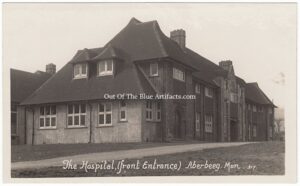 The Official Opening of the Abertillery and District Hospital.
The Official Opening of the Abertillery and District Hospital.
On Saturday 30th of September 1922, the Abertillery and District Hospital at Christchurch, Aberbeeg (as seen left) was officially opened. The opening ceremony took place at 4.00pm by Mr Thomas H. Mytton. The opening ceremony was brief as could be owing to the awful weather conditions, though some of those present were as follows – Mr G. Barker M.P.; Mrs Barker; Mr T. H. Mytton and Mrs Mytton; Mr J. Snellgrove; Mr Victor Roberts (General Secretary); Mr Wyndham Collier (Financial Secretary); Miss M. J. Downing (Matron); Drs W. J. Greer; R. J. Coulter and T. I. Candy of Newport; Mr Walter Rosser M.S.A. (Architect) and Mrs Rosser; Mr J. H. Monks (Contractor) and Mrs Monks; Mr John Williams (Surveyor to the Abercarn Council) and Mrs Williams; Dr T. B. Smith (Medical Officer to the Abertillery Council); Mr S. Padfield (Sanitary Inspector); Mr R. Prosser (Accountant); Dr S. Simons; Dr and Mrs E. Ryan of Crumlin; Dr T. J. Carruthers of Llanhilleth; Revs H. S. Rees and T. Reeves of Abertillery; Rev W. M. Davies of Six Bells; C. J. Harding of Six Bells; Alderman Levi Harris; Mrs T. Adams; Mrs R. Green; Messrs F. Athay; D. Thomas; L. Elliott; W. Williams; F. W. Chivers; A. Parry; W. Frowen J. P.; C. W. Dawe; Ivor Warfield (Under Manager of the Gray Colliery); Richard Lewis (Under Manager of the Arrael Griffin No4 Colliery); Arthur Davies; Theo Evans; A. E. Meredith; Oswald Elliott; Thomas Jenkins (Manager of the Aberbeeg Colliery); Mr Opton Purnell (Western Valley’s Miners Council) and Mr J. Pitman of Blaina.
It was originally intended to form a procession at the Drill Hall, Abertillery accompanied by the Abertillery Town and Salvation Army Bands, members of the Ambulance and Nursing Divisions and other well-known local organisations. The procession was to be marshalled by Alderman Levi Harris, Councillor W. T. Williams, Messrs W. Williams, Emlyn Phillips, F. Padfield and John Davies who would proceed to the Abertillery District Hospital by two different routes, one section branching off at Six Bells and taking the old road whilst the other group take the road through Six Bells. The two parties would then meet at the Hanbury Hotel and the whole procession would walk to Christchurch. Flags and souvenirs were to be sold en-route. Though on the day of the opening ceremony it was raining so bad, the weather put many people off from attending parade.
Those that did take part in the procession were – The Abertillery Salvation Army Band with Mr A. Veal (Bandmaster); The Abertillery Nursing Division with Mrs Strickland (Superintendent); The Abertillery Ambulance Brigade with Mr J. Matthews (Superintendent); The Six Bells Ambulance Brigade with Mr J. Hooper (Superintendent); The Abertillery Battalion G.L.B. G.L.B., with Mr A. E. Davies (Commandant) and Mrs S. Padfield (Lieutenant); The Abertillery Fire Brigade with Mr Rancombe (Chief Officer); The Abertillery Battalion Boys Brigade Mr H. Mytton (Captain) with Mrs H. Mytton; O. T. Briscoe (Captain); The Abertillery Battalion Girl Guides with G. Gibbs (Captain): The procession went via Warm Turn and met up with others at Aberbeeg before proceeding to the Abertillery District Hospital.
The religious service was conducted by Rev H. S. Rees and Rev Thomas Reeves. The service included the following hymns – “O God Our Help in Ages Past” “Thine Arm O Lord in Days of Old” and the prayer of dedication – “In the faith of Jesus Christ we dedicate this hospital to the Glory of God and for the healing of the sick and comfort of the dying. In the name of the Father, the Son and the Holy Ghost Amen. Immediately after the service Miss Mattie Monks, the daughter of the Contractor Mr John Henry Monks, presented Mrs Mytton with a bouquet of flowers. Mr Monks then handed a Golden Key to the main door to Mr T. Mytton, after a few words Mr Mytton opened the door and the public were invited in to view the building.
It was reported by the hospital committee that they had hoped to build the Abertillery District Hospital free of debt but owing to the depression in trade that didn’t happen, therefore the hospital was opened under a debt of £20,000 which at 5 per cent meant that £1,000 per annum interest had to be paid. The 32 beds that were to be placed in the district hospital and the costs for maintenance would be £111 per annum, that would require £4,000 and £5,000 per annum in addition. On top of that the staff and running expenses. Mr Mytton spoke of how they had tried their best to get financial aid from the government but had failed.
The government had appointed a commission to enquire into the hospital question for Great Britain under the presidency of Lord Cave. The came to a decision to find £1,000,000 to relieve hospitals of the financial difficulties after the war, though Sir Alfred Mond ruthlessly cut that figure in half. Up until June he only knew of £234,000 being spent from that fund, the highest grant of £13,000 was given to the Middlesex Hospital in London and the lowest was £25 to Ashburton Cottage Hospital, the Royal Gwent Hospital Newport received just £365 and he believed that Blaina Hospital had received some aid.
On a lighter note, at the opening ceremony a competition was organised for the benefit of the hospital, participants paid 6d. each for a raffle ticket and the prize was a 10/- shilling note. The winning number was No99, when opened in front of the audience by Mr T. Mytton it turned out to be the ticket of Mr George Barker M.P. and Mr Mytton was with him when he first purchased the ticket. Mr Barker gave the prize to the hospital fund.
Description of the Hospital.
The work was carried out by Mr John Henry Monks of Newport at an estimated cost of £40,000 to £50,000. The architect was Mr Walter Prosser M.S.A., of Newport and London.
The Abertillery and District Hospital was situated in 9 acres of land, built of brick throughout, the front elevation of the administrative block was faced with special handmade rustic bricks and the remaining elevations with common brick rough-casted and distempered. The roof was made with special handmade rustic tiles to harmonise with the natural surroundings. In the building all the angles were rounded and in most rooms and corridors, the dadoes were tiled with special tiles and the walls and ceilings above were painted white and enamelled. Inter-communication telephones were installed throughout. The hospital had been built so as further extensions could be added if or when necessary. The building consisted of three blocks.
The First Block.
The first block being the admission and administrative department on the ground floor and staff quarters on the first floor. The admission department consisted of a waiting room, examination room, surgical dressing room and a room for eye, ear and throat treatment. The administrative department on the ground floor comprised a porter’s room, waiting room, surgeons and nurse’s rooms, kitchen, surgery, kitchen staff sitting room, a scullery and various stores. On the first floor was matron’s bedroom, nine bedrooms for the staff and a large room for meals, reading and recreation rooms.
Second Block.
From the main entrance in the administrative block, the main corridor gave access to the second block which contained two wards right-and-left. The wards have an axis from north to south that gave the maximum amount of sunshine, windows were arranged on either side of each bed. Each ward had had accommodation for sixteen beds with a side ward and day room. Adjoining the day rooms were verandas onto which patients could be wheeled out to obtain sunshine with plenty of shelter if needed. The ward units consisted of mainly duty rooms, sister’s rooms, ward sculleries, laboratories, surgical dressing rooms, linen and patient’s clothes stores.
The Third Block.
The third block at the end of the main corridor contained the operating room (lined with large slabs of white vitrolite). Rooms for anaesthetics, sterilising instruments, supplies and blanket warming together with robing rooms for nurses and surgeons. The x-ray block consisted of an x-ray room, with a dressing recess, a sister’s room, treatment room and a dark room.
A separate building was erected in close proximity to the hospital in which an electrical generating plant had been installed and the hospital was lighted throughout by electric installed by Messrs Marler & Co Ltd, Newport. The hospital was heated by low pressure steam through radiators and heating coils, this work together with all the plumbing and the steam cooking apparatus was carried out by Messrs Beaven & Sons Ltd of Newport.
At the back of the electrical generating station was a small mortuary, though planning was put forth for the erection of a permanent mortuary, a laundry and a garage, all of which would be built at a later date.
Tender for Nurses.
In October 1922 tenders were invited for a fully trained staff nurses required to attend to 32 beds at the Abertillery and District Hospital, Aberbeeg. The post was with a salary of £60 per annum with an additional £8 for one experienced in x-ray work. With board, laundry and uniform.
All applications to be sent to Mr Victor Roberts, Secretary, 44 Evelyn Street, Abertillery, Mon. Dated October 1922.
Doctors Appointed.
In January 1923 the various doctors and specialists were appointed the Abertillery and District Hospital. Dr W. Collins, M.B., Ch.B., M.R.C.S., M.R.C.P., was appointed House Surgeon. Mr William Jones Greer as Consulting Surgeon. Dr Robert James Coulter and Dr John Albert Lee were the Eye, Nose & Throat Specialists.
Hospital Inspections by the Public.
Owing to the bad weather on the day of the official opening, the public were invited to inspect the Abertillery and District Hospital throughout the week commencing Monday 16th October 1922 from 9.00am to 1.00pm and from 2.00pm to 8.00pm. It was organised as to allow the following parties to attend – Monday – The Arael Griffin Lodges No4 and No5. Tuesday – The Vivian and Gray Lodges. Wednesday – The Townspeople, Municipal Employees and the N.U.T. Thursday – The Tinworkers, Railway men and Bricklayers. Friday – The Unemployed and the Rose Heyworth Lodge. Saturday – The Tillery and Cwmtillery Lodges. Sunday – Aberbeeg and Llanhilleth.
The First Patient to be Treated.
On Monday 8th of January 1923, Mr Stephen Albert Williams, a builder who was repairing the Roman Catholic Church, Abertillery was knocked down by a scaffolding pole as it was being lowered to the ground, he sustained injuries to his head and was admitted into the Abertillery and District Hospital. Mr Williams was the very first patient to be treated at the hospital. It was reported his injuries were not serious.
On Wednesday 17th of January 1923, a serious accident occurred at the Areal Griffin Colliery, Six Bells. Two shoeing smiths named Mr Caleb Powis and Mr David Cosker were descending the pit with Mr Charles Wickham, a Deputy Fireman. Something went wrong with the winder and within yards from the bottom of the pit the cage fell with such a speed as to inflict serious injuries on the occupants. Mr David Cosker had his thigh broken and Mr Caleb Powis suffered a fractured ankle. Both men were taken to Abertillery and District Hospital, while Mr David Wickham received lesser injuries though suffered a fracture to his leg and was taken home on a stretcher. It was stated that there were three electricians in the ascending cage who sustained no injuries.
The First Six In-Patients.
The first six in-patients at the Abertillery and District Hospital were named as being – Mr David Cosker and Mr Caleb Powis, the two colliery accident cases previously mentioned. Mrs Pugh of 83 Richmond Road, Abertillery. Mr Tradford of Alma Street, Abertillery. Mrs Turner of Warm Turn, Aberbeeg and Mrs Robbins of Llahilleth.
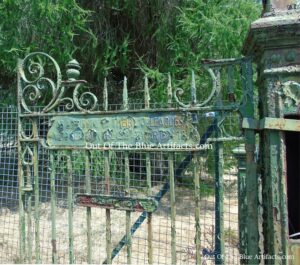 The Hospital Memorial Gates.
The Hospital Memorial Gates.
Ever since the institution was opened, the Abertillery and District Hospital, Aberbeeg had been in need of suitable entrance gates. It was reported that the members of the local branch of the National Association of Local Government Officers had a scheme for the provision of gates as a memorial to the two members of staff who fell in the Great War. Sixteen members of the staff joined the colours and two made the supreme sacrifice – Messrs W. M. Keyes and J. S. Metcalfe. The report also mentioned a former member of the council Mr Ieuan Phillips died of wounds received.
The sixteen council staff who served in the Great War were as follows – L. D. Lewis; C. Bevington; T. Jones; D. R. Williams; G. Hoskins; C. C. Courthoys; H. J. Williams; A. Gait; E. J. O’Connor; R. Prosser; J. S. Metcalfe; D. Richards; W. T. Nicholas; W. M. Keyes; A. J. Dando and Dr T. B. Smith: Two were wounded and one taken prisoner. It was stated fourteen members had later returned to civilian life with the two reported as killed or missing were – W. M. Keyes of Abertillery and J. S. Metcalfe of Ambleside, North of England.
The formation of the War Memorial Fund was established in 1919 by the staff with the secretarial work being carried out by Messrs A. J. Cottle and D. R. Davies. The Memorial Gates were made by Messrs Bayliss, Jones & Bayliss of Wolverhampton at a cost of £140 and was erected Mr Robert Coulston Jones, builder living at 11 Duke Street, Abertillery, under the direction of Mr Gordon Jones, Surveyor to the Abertillery District Council.
The Unveiling of the Memorial Gates.
On Saturday 13th of December 1924, the Memorial Gates were unveiled and Mr Thomas Mytton presided over the Dedicatory and Presentation Service. The service commenced with the singing of the Hymn “O God Our Help in Ages Past” followed by a prayer by Mr Padfield. The Rev T. Madog Williams the Vicar of Cwmtillery read a portion of Scripture – Revelation Ch. 21. Dr T. Baillie Smith spoke a few words and Mr Arthur Llewellyn presented the Key to Mr W. Gait (Clerk of the Council), who after the Dedicatory Prayer by Rev T. Madog Williams, formally opened the Memorial Gates which bore bronze tablets inscribed “These Gates are presented by the Abertillery Municipal Officers as a tribute to their colleagues who served in the Great War”. The gates were then handed over the representatives of the hospital committee.
The Presentation of the Memorial Gates.
Mr Gait in making the presentation said – “My duty is to ask the trustees, managers and representatives or by whatever name they are referred to in the trust deeds of the institution, to formally accept from us by way of presentation these beautiful Memorial Gates, which will from this day forward be the absolute property of the hospital authorities and form part and parcel of the fabric of the institution and be dealt with by them in common with the general buildings, subject to this reservation, that the gates, with the tablets thereon, shall at all times be maintained as “Memorial Gates” . “I ask the representatives of the hospital committee to formally accept the presentation on the terms stated”. Mr D. R. Davies on behalf of the council staff placed on the gates a wreath bearing the inscription – In loving memory to our fallen comrades, National Association of Local Government Officers, Abertillery branch. The service concluded with the singing of the hymn “We Give Thee But Thine Own” and the pronunciation of the Benediction by Rev T. Madog Williams.
The last post and reveille were sounded by Bugler Hayes of A. Company 3rd Battalion of the Monmouthshire Regiment.
Tea was provided at the Hanbury Hotel, Aberbeeg and in the evening Mr George Barker M.P., presided over the subsequent proceedings.
The Memorial Television Set.
In July 1957 Mrs O. Ralph of Gladstone Street, Abertillery presented a TV set to the women’s ward at the Aberbeeg Hospital in memory of her sister Mrs Annie Brooks of Wattsville. Present at the ceremony were – Mr Bill Ralph; Mrs O. Ralph; Matron Miss G. E. Body and Mrs Iris Wiltshire the daughter of Mrs Brooks.
The Naming of the Hospital Wards.
On Friday 31st of October 1958, the South Wales Gazette reported on two hospital wards being named after two well-known medical men – Professor Gilbert Strachan and the late Dr John Dunlop, to mark their services to the hospital. Professor Strachan whose name appeared over the female ward had been consultant gynaecologist and obstetrician at the Hospital since 1924. Dr Dunlop’s name appeared over the male ward and had been consultant surgeon at the hospital from 1923 to 1942.
The Official Naming of the Wards Ceremony.
The official naming ceremony took place on Thursday 30th of October 1958, the Matron Miss G. E. Body unveiled a plaque citing Professor Strachan’s services to the hospital and Mr R. W. Scanlon unveiled a plaque commemorating Dr Dunlop’s services. Alderman Mrs L. P. Jones Chairman of the Hospital House Committee paid tribute to Professor Strachan, responding Professor Strachan said it had been a privilege to serve the hospital and expressed his gratitude for the honour bestowed on him. Councillor Mrs Florence Brown spoke for Dr Dunlop, on behalf of the family Mr Edward Dunlop, son of Dr Dunlop thanked the hospital committee. Others who attended were as follows – Mr Eugene Cross (Chairman) of the North Monmouthshire Hospital Management Committee; Alderman T. H. Mytton (Patron of the Hospital) and Mrs E. Newbold (Vice Chairman) of the Hospital House Committee.
The Javelin Jet Incident 1958.
In December 1958 Flight Lieutenant Anthony Morgan of Sherwood, Nottingham was a navigator of a Javelin Jet flying over Abertillery. The pilot, Squadron Leader L. Gregory was flying the Jet, belonging to the Gloster Aircraft Co to Moreton Valance, at Gloucester when there was a problem with aircraft. The jet was on a test flight and Flight Lieutenant A. Morgan was told to bail out, he fell 6,000 feet but upon his descent his parachute was burnt by high tension power cables with which he fell the last twenty feet without anything to break his fall.
Flt Lieut Morgan landed close to Aberbeeg, witnessed by Mrs Harriet Bayliss of Glandwr Street Aberbeeg, Mr Joseph James of Brunant Cottages and police constable R. J. Clark. He had landed and was found in a small pool of water, injured but conscious he was taken to Aberbeeg Hospital for treatment. The pilot of the Javelin Jet, Squadron Leader L. Gregory regained control of the aircraft and flew on to Gloucester.
It was later reported that the “faster than the speed of sound” Jet had taken off from the R.A.F. Airfield at Aberporth, West Wales and got into trouble over Swansea. Flight Lieutenant Anthony Morgan, as ordered, bailed out over Aberbeeg and his ejector seat was found in Crospenmaen, the force of the ejection blew off Flt Lieut Morgan’s boots.
The Hadley Patient-to-Nurse Call System.
In September 1963 Aberbeeg Hospital operated the “Hadley Patient-to-Nurse Call System”, along with headphones for radio and television. The system enabled a patient to call a nurse by pressing a button at the bedside.
The Closure of the Aberbeeg Hospital.
In February 1969 the South Wales Gazette reported on the closure of Aberbeeg Hospital as the new Nevill Hall Hospital was being constructed and all operations and nursing would be transferred to the new hospital at Abergavenny. At Blaina the small specialist out-patient department was to be moved to Abergavenny while the in-patient’s departments for Ophthalmology and E.N.T. surgery was centralised in new units at St Woolas and Royal Gwent Hospitals. The general practitioner’s medical unit was retained.
The Welsh Hospital Board’s complete proposals included the closure of the Blaenavon Workmen’s Hospital, the Rookery Annexe, Ebbw Vale and the Crickhowell War Memorial Hospital in addition to the Abertillery Hospital at Aberbeeg.
(Later information to come).
Notes of Interest – Throughout the time the Abertillery and District Hospital was being planned between 1870 and 1922, many organisations, too many to put in writing, organised many many fundraising events with lists of monies collected. These lists along with the donators and subscribers are again too many to put in writing. If anyone has any special requests for names, money collected etc for any given date or time please ask and I will try and supply any relevant information.
The above information on the Abertillery and District Hospital is only a brief timeline of events which led up to its creation, eventually! There were many people involved in its funding, planning and building, the thousands of townspeople, those for and those against, initially, did in the end come together as one and gave the hospital committee strength and support to carry out their objective and to give the district an institution to be proud of.
 Out Of The Blue Artifacts A Library of a lifetime of collecting
Out Of The Blue Artifacts A Library of a lifetime of collecting
